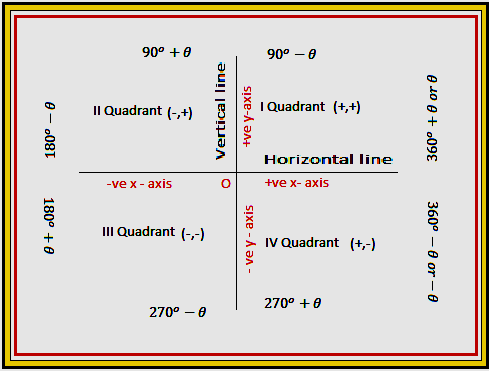Featured Posts
Basics & Formulas Ch-3 Class11 | Trigonometry
- Get link
- X
- Other Apps
|
|
0o
|
30o
|
45o
|
60o
|
90o
|
180o
|
270o
|
360o
|
|
Sin
|
0
|
1/2
|
\[1/\sqrt{2}\]
|
\[\sqrt{3}/2\]
|
1
|
0
|
-1
|
0
|
|
Cos
|
1
|
\[\sqrt{3}/2\]
|
\[1/\sqrt{2}\]
|
1/2
|
0
|
-1
|
0
|
1
|
|
Tan
|
0
|
\[1/\sqrt{3}\]
|
1
|
\[\sqrt{3}\]
|
\[\infty\]
|
0
|
\[\infty\]
|
0
|
|
Cot
|
\[\infty\]
|
\[\sqrt{3}\]
|
1
|
\[1/\sqrt{3}\]
|
0
|
\[\infty\]
|
0
|
\[\infty\]
|
|
Sec
|
1
|
\[2/\sqrt{3}\]
|
\[\sqrt{2}\]
|
2
|
\[\infty\]
|
-1
|
\[\infty\]
|
1
|
|
cosec
|
\[\infty\]
|
2
|
\[\sqrt{2}\]
|
\[2/\sqrt{3}\]
|
1
|
\[\infty\]
|
-1
|
\[\infty\]
|
Trigonometric Transformations at 90o (I and II Quadrant) | ||||
sin(90 - θ) | +cosθ | sin(90 + θ) | +cosθ | |
cos(90 – θ) | +Sinθ | cos(90 + θ) | -Sinθ | |
tan(90 - θ) | +cotθ | tan(90 + θ) | -cotθ | |
cot(90 - θ) | +tanθ | cot(90 + θ) | -tanθ | |
sec(90 - θ) | +cosecθ | sec(90 + θ) | -cosecθ | |
cosec(90 - θ) | +secθ | cosec(90 + θ) | +secθ | |
Trigonometric Transformations at 180o (II and III Quadrant) | ||||
sin(180 - θ) | Sin θ | sin(180 + θ) | -Sin θ | |
cos(180 – θ) | -Cos θ | cos(180 + θ) | -Cos θ | |
tan(180 - θ) | -tanθ | tan(180 + θ) | +tanθ | |
cot(180 - θ) | -cotθ | cot(180 + θ) | +cotθ | |
sec(180 - θ) | -secθ | sec(180 + θ) | -secθ | |
cosec(180 - θ) | cosecθ | cosec(180 + θ) | -cosecθ | |
Trigonometric Transformations at 270o | ||||
sin(270 - θ) | -cosθ | sin(270 + θ) | -cosθ | |
cos(270 – θ) | -Sinθ | cos(270 + θ) | +Sinθ | |
tan(270 - θ) | +cotθ | tan(270 + θ) | -cotθ | |
cot(270 - θ) | +tanθ | cot(270 + θ) | -tanθ | |
sec(270 - θ) | -cosecθ | sec(270 + θ) | +cosecθ | |
cosec(270 - θ) | -secθ | cosec(270 + θ) | -secθ | |
Trigonometric Transformations at 360o | ||||
sin(360 - θ) | -Sin θ | sin(360 + θ) | +Sin θ | |
cos(360 – θ) | +Cos θ | cos(360 + θ) | +Cos θ | |
tan(360 - θ) | -tanθ | tan(360 + θ) | +tanθ | |
cot(360 - θ) | -cotθ | cot(360 + θ) | +cotθ | |
sec(360 - θ) | +secθ | sec(360 + θ) | +secθ | |
cosec(360 - θ) | -cosecθ | cosec(360 + θ) | +cosecθ | |
Trigonometric Transformations at 0o | ||||
sin(0 - θ) | -Sin θ | sin(0+θ) | + Sin θ | |
cos(0 - θ) | +Cos θ | cos(0+θ) | + Cos θ | |
tan(0 - θ) | -tanθ | tan(0+θ) | + tanθ | |
cot( 0-θ) | -cotθ | cot(0+θ) | + cotθ | |
sec( 0-θ) | +secθ | sec(0+θ) | + secθ | |
cosec( 0-θ) | -cosecθ | cosec(0+θ) | + cosecθ | |
|
Degree
Measure
|
30o
|
45o
|
60o
|
90o
|
180o
|
270o
|
360o
|
|
Radian
Measure
|
\[\frac{\pi
}{6}\]
|
\[\frac{\pi
}{4}\]
|
\[\frac{\pi
}{3}\]
|
\[\frac{\pi
}{2}\]
|
\[\pi\]
|
\[\frac{3\pi
}{2}\]
|
\[2\pi\]
|
Solution: Since angle lie in the II quadrant. Therefore
\[\frac{\pi }{2}<x<\pi \Rightarrow \frac{\pi }{4}<\frac{x}{2}<\frac{\pi }{2}\]⇒ Angle x/2 lie in the first quadrant and in first quadrant sinx/2, cosx/2 and tanx/2 all are positive \[tanx=\frac{-4}{3}=\frac{P}{B}\]\[\Rightarrow P= 4k,\: and\: B= -3k\]\[In\: \: \Delta OAB,\; OA=\sqrt{(4k)^{2}+(3k)^{2}}=5k\]\[Now\: \: cosx =\frac{B}{H}=\frac{-3k}{5k}=\frac{-3}{5}\]\[sin^{2}\; \frac{x}{2}=\frac{1-cosx}{2}=\frac{1-(\frac{-3}{5})}{2}\]\[sin^{2}\; \frac{x}{2}=\frac{1+\frac{3}{5}}{2}=\frac{8}{2\times 5}=\frac{4}{5}\]\[sin\; \frac{x}{2}=\sqrt{\frac{4}{5}}=\frac{2}{\sqrt{5}}\]\[cos^{2}\: \frac{x}{2}=\frac{1+cosx}{2}=\frac{1-\frac{3}{5}}{2}\]\[cos^{2}\: \frac{x}{2}=\frac{2}{2\times 5}=\frac{1}{5}\]\[cos\: \frac{x}{2}=\sqrt{\frac{1}{5}}=\frac{1}{\sqrt{5}}\]\[tan\frac{x}{2}=\frac{sin\frac{x}{2}}{cos\frac{x}{2}}=\frac{2/\sqrt{5}}{1/\sqrt{5}}=2\]
|
Worksheet(1) for the students (Pair
the following) |
|
|
Which do not have any pair write answer for
them also |
|
|
1)
\[tan2x\] |
a) \[sinx\] |
|
2)
\[\frac{tan2x}{1+tan^{2}x}\] |
b)
\[\frac{2tan\frac{x}{2}}{1-tan^{2}\frac{x}{2}}\] |
|
3)
\[2cos^{2}\frac{x}{2}-1\] |
c)
\[\frac{2tan\frac{x}{2}}{1+tan^{2}\frac{x}{2}}\] |
|
4)
\[sinx\] |
d)
\[\frac{2tanx}{1-tan^{2}x}\] |
|
5)
\[\sqrt{1-cos^{2}x}\] |
e)
\[|sinx|\] |
|
6)
\[\frac{1-tan\frac{x}{2}}{1+tan\frac{x}{2}}\] |
f)\[sin2x\] |
|
g)\[sinx\] |
|
|
7)
\[sec^{2}x-1\] |
h)\[cosx\] |
|
8)
\[\frac{1-tan^{2}\frac{x}{2}}{1+tan^{2}\frac{x}{2}}\] |
i)
\[2sin\frac{x}{2}cos\frac{x}{2}\] |
|
j)
\[tan\left ( \frac{\pi }{4}-\frac{x}{2} \right )\] |
|
|
9)
\[cosAcosB+sinAsinB\] |
k) \[cos(B-A)\] |
|
10)
\[tan\left (\frac{\pi }{4}+x \right )\] |
l)\[cos(A+B)\] |
|
m)
\[\frac{1+tanx}{1-tanx}\] |
|
|
Worksheet(2) for the students Pair
the following |
|
|
1) \[\sqrt{1-cosx}\] |
a\[\frac{tanA-tanB}{1-tanAtanB}\] |
|
2) \[\sqrt{1+cosx}\] |
b
\[4cos^{3}x-3cosx\] |
|
3) \[\sqrt{1-sin2x}\] |
c
\[\frac{3tan-tan^{3}x}{1-3tan^{2}x}\] |
|
4) \[\sqrt{1+sin2x}\] |
d
\[sinAcosB-cosAsinB\] |
|
5) \[sin3x\] |
e
\[3sinx-4sin^{3}x\] |
|
6) \[cos3x\] |
f
\[|cosx-sinx|\] |
|
7) \[tan3x\] |
g
\[\left |\sqrt{2}sin\frac{x}{2} \right |\] |
|
8) \[sin(A-B)\] |
h
\[|cosx+sinx|\] |
|
9)
\[tan(A-B)\] |
i \[\left |\sqrt{2}cos^{2}\frac{x}{2} \right |\] |
Answer Key: (1, g), (2, i), (3, f), (4, h), 5, e), (6, b), (7, c), (8,
d), (9, a)
- Get link
- X
- Other Apps
Comments









I found this very interesting and helpful
ReplyDelete